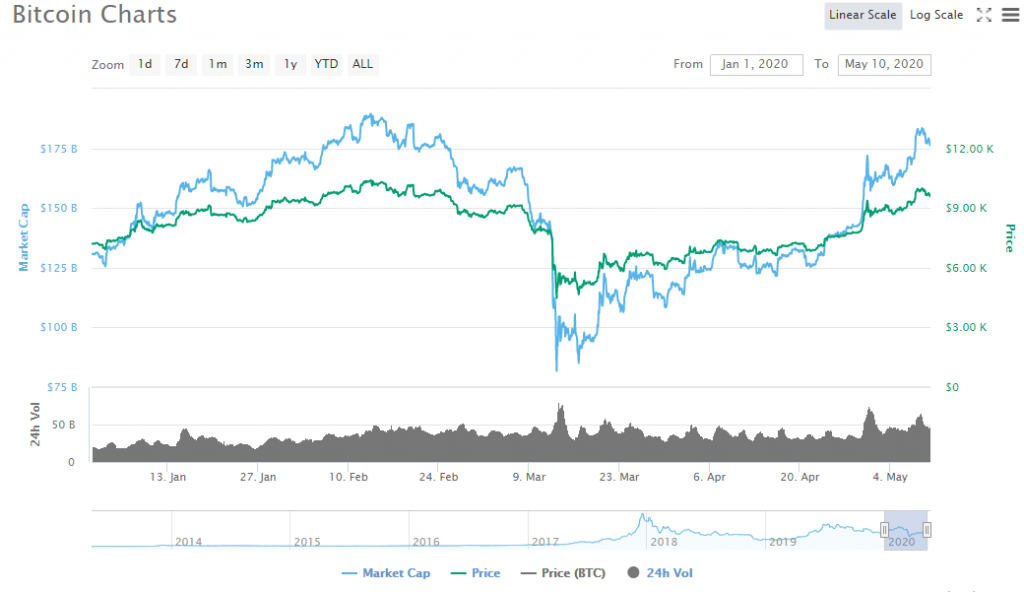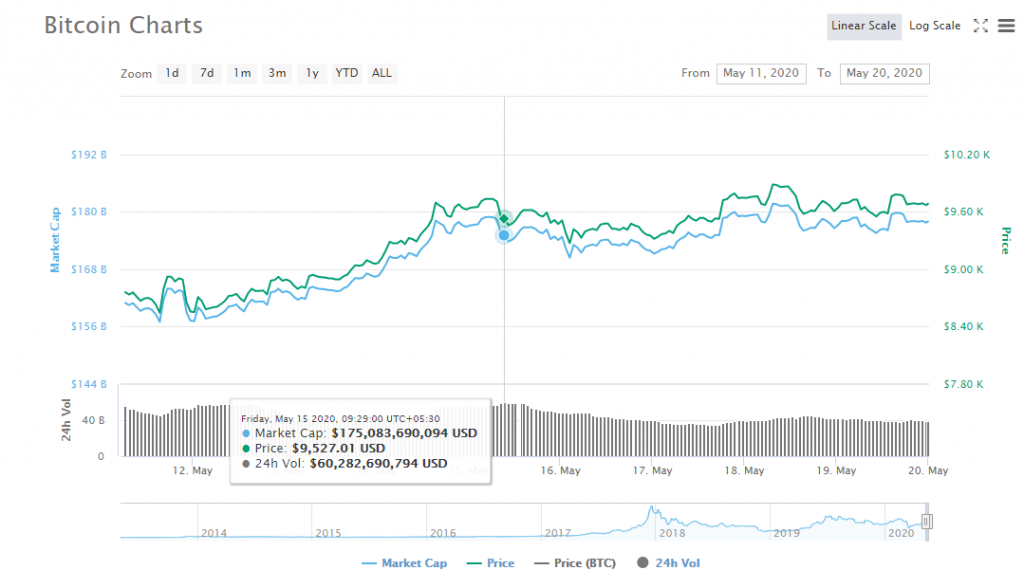Table of Contents
Whether you are a newbie or an advanced trader, whether a developer of DApps or miners of Bitcoins or even a crypto enthusiast, you must be well aware of the “Halving” event of crypto space. Crypto community all across the globe was eagerly waiting for the event till May 11, 2020, when the third halving took place. But this time, the situation is a little different from the previous two events because of the impacts of the global pandemic of COVID-19. The infamous Corona is not only associated with health crises but with global economic slowdown also. Crypto space had not been left untouched by the virus of COVID even though it is based on the decentralized model of Blockchain technology. Also the hype and impacts of Corona on Bitcoin Halving 2020 have been noticed. Some of crypto giants though explained that the immediate impact on Bitcoin prices was not observed even in two previous halving events, so maybe it is not Corona but the usual trend in crypto markets. In this article, let us have a closer view of the halving event of 2020 and also try to understand the impact of COVID-19 on Bitcoin Halving.
What Is Bitcoin Halving?
Technically, Bitcoin halving is the inflation control event in the crypto space. Bitcoin protocol was pre-programmed with a limited supply of 21 million Bitcoins. When a new Bitcoin enters the crypto sphere (every 10 minutes) with the efforts of miners who are constantly involved in solving the complex mathematical algorithm and validating the transaction. With every block mined or Bitcoin introduced, miners, are being rewarded with some Bitcoins as the compensation for their computational power utilized and incentives to keep up with the process of mining Bitcoins. So, to control the rate at which the Bitcoins are introduced in the market, rewards given to miners tend to half every four years, called a Bitcoin Halving event.
Brief Of Halving 2012 And Halving 2016
Since the launch of Bitcoin in 2009, the halving of 2020 was a third-time event. Previously, halving took place in July 2016 when rewards halved from 25 BTC to 12.5 BTC, and the first time it took place in November 2012 when the initial reward of 50 BTC was halved to 25 BTC. Both the halving effects impacted the price of BTC resulting in 81 times in 2012 and 30 times in 2016 within the duration of almost 18 months, thereby creating the bull run. The point could be noted that immediate impact was not noticed but the long term trend in the surging prices of Bitcoin prices was noticed in both the events. When new buyers came into the market and demanded for Bitcoins, the prices were raised. It can be employed that actually controlled supply did not affect the price but demand for Bitcoins influenced the prices, following the simple law of “Price-Demand” of traditional markets.
Bitcoin Halving 2020 | Impacts of COVID-19

On May 11,2020, the Bitcoin Halving 2020 took place when the reward to incentivize miners were reduced to 6.25 BTC from 12.5 BTC per block. Simple logic was followed this time halving too that- if the supply of BTC decreases but the demand remains almost the same, then the price of BTC will increase. And in case the demand will increase then the prices of BTC can significantly move to attract fresh investments too. But this time, the situation is a bit different from the other two events majorly due to the impacts of COVID-19 all across the globe and a few other factors.
Overview Of Prices of Bitcoin- Jan-May, 2020 | Before Halving 2020

- At the beginning of the year 2020, the prices of Bitcoin shot up from $3300 to $12,000(more than 47%). Many of the crypt enthusiasts argued that halving had already been priced in and accordingly the majority of smart investors had made the supply adjustments to assure their profits. Many of the analysts predicted that the upward trend will be observed for the coming years after halving.
- Like other investment classes, Bitcoin was also collapsed by the effects of COVID-19 in Mid of March,2020 when the price dropped below $5000 within 24 hours (more than 60%). Investors started taking off their money and the demand for Bitcoin started reducing.
- Thanks to the volatile nature of crypto markets and the expected Bitcoin halving 2020 countdown which again surged the demand for Bitcoins leading to rebounding of prices of Bitcoin up to 160%. The sharp rise was noticed in both demand and prices of Bitcoin a few days before Halving. The deflationary impact of the pandemic started diluting in crypto space, though the swing in impacts was highly huge.
Overview of Prices of Bitcoin After May 11,2020 | After Halving 2020

Billionaire Bitcoin bull Tim Draper advocated that price of one BTC could raise up to $250,000; former Goldman Sachs GS, Raoul Pal predicted the price of BTC to raise up to $1,000,000 within 3 years while the Silk Road founder Riss Ulbricht employed that the rice may it $333,000,000 within few decades, before the Bitcoin Halving 2020. Till the time COVID 19 hit the world, crypt enthusiasts were far more than optimistic related to prices of Bitcoin. But the Black Swan event turned the world around leading to the economic slowdown, liquidity crunch, and dropping of prices of Bitcoin too.
While relating Bitcoin Halving and COVID-19, analysts and crypto traders are having mixed opinions. Ryan Watkins, research analyst at Messari believes that the outbreak of Corona is a major obstacle in a bull run after halving while on the other hand, Jake Yocom-Piatt, project lead at Decred advocated that pandemic will prove as opportunity to Bitcoin Halving. Let us throw light upon some of the factors and try to understand if it is actually COVID 19 which impacted the Halving or prices of BTC after halving or it is the nature of crypto space.
- Earlier when halving took place, the derivatives market of crypto was in its infant stage, the involvement of institutional investors was minimal and the analytical tools were merely new. Market was merely affected by the process of mining but now during the third halving event, besides COVID-19, there are tons of factors affecting the market. Latest ICOs, announcements of partnerships, new products and services, self-adjustments tools, already analyzed impacts with analytical tools and technical analysis, whales of spaces, and many more affect the crypto space.
- In the previous two halving events, the impact on price was not noticed in a few days or weeks but the impacts were seen almost after a year. So, blaming the Corona for the prices of BTC not being bullish after Halving might not be justified. Let us just wait for a few months to finally advocate the long term effects of Halving.
- COVID-19 might be considered as one of the factors in reducing the hash rate of the mining process. As the pandemic led to the lowering down of manufacturing and movement of Bitcoin mining hardware, so the small miners might drop down the process of mining after the rewards get reduced to half. Jay Hao, the CEO of cryptocurrency exchange OKEx also stated that COVID and halving can prove as misfortunes for small Bitcoin miners.
- The Bitcoin halving event amid the global pandemic might prove to be the “safe haven” asset for the majority of investors. As the COVID had squeezed up the global economy resulting in the expected inflationary atmosphere, Bitcoin can become an alternative to hedge the economic issues. Now when the demand is expected to increase in the digital currencies, its supply has been reduced which may result in an increase in prices of Bitcoin.

Thus, it can be concluded that COVID-19 had impacted the event of Bitcoin halving 2020. But if someone asks me- why bitcoin halving 2020 is not successful? Then, I could only respond that it happened just a week ago and we need to wait to notice long term impacts. It is merely difficult to predict this time that what will happen in the coming months if the global economy will ramp, if the second wave of Corona will hit the world more drastically, if everything becomes normal and many more situations. We could just hope that the prices and demand for Bitcoin will increase in the coming decades.

